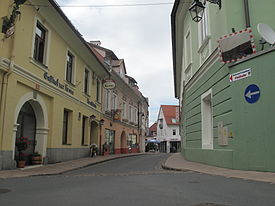- Feldkirchen in Kärnten
-
Feldkirchen in Kärnten Country Austria State Carinthia District Feldkirchen Mayor Robert Strießnig (SPÖ) Area 77.49 km2 (30 sq mi) Elevation 554 m (1818 ft) Population 14,276 (1 January 2011)[1] - Density 184 /km² (477 /sq mi) Time zone CET/CEST (UTC+1/+2) Postal code 9560 Website www.feldkirchen.at Feldkirchen in Kärnten (Slovene: Trg) is a town in the Austrian state of Carinthia and the capital of the district of the same name. It consists of the Katastralgemeinden Fasching, Feldkirchen, Glanhofen, Gradisch, Hoefling, Klein Sankt Veit, Pernegg, Rabensdorf, Sankt Ulrich, Sittich, Tschwarzen and Waiern.
Contents
Geography
Location
Feldkirchen is located on the northern edge of the Klagenfurt Basin at the junction of the federal highways (Bundesstraßen) B 93 Gurktal Straße toward Friesach, B 94 Ossiacher Straße to Villach and B 95 Turracher Straße to Klagenfurt. Both the Glan river and the small Tiebel, main inflow of Lake Ossiach, run though the town.
Neighbouring municipalities
Himmelberg Steuerberg Sankt Urban Steindorf 
Glanegg Ossiach Velden Techelsberg Moosburg History
The settlement may have developed at the site of the former Beliandrum mansio along the Roman road from Teurnia near Spittal an der Drau to Virunum, capital of the Noricum province. A Roman tombstone of the 2nd century is included into the walls of the Saint Michael filial church. The earliest mention of Feldkirchen is as Ueldchiricha ("Church in the Fields") in a 888 document by Arnulf of Carinthia. The parish church Maria im Dorn, a Romanesque basilica with a Carolingian choir, is one of the oldest sacred buildings in Carinthia.
Feldkirchen, once an estate of the Eppenstein noble family, was bequeathed to the Diocese of Bamberg in 1166. The bishops had the Amthof erected, the former seat of the local administration, today a place for cultural events and a small museum. Finally Maria Theresa of Austria acquired Feldkirchen in 1759. The village of Markstein south of the town centre is a former checkpoint at the border between the Austrian Empire and the Upper Carinthian part of the short-lived Napoleonic Illyrian Provinces. The building of a customs station and a border stone remained. Feldkirchen received town privileges in 1930.
Gallery
Demographics
According to the 2001 census, Feldkirchen has 14,030 inhabitants. Of that, 77.1% admit themselves to the Roman Catholic Church, 12.0% are Evangelist, 0.8% belong to the Orthodox Church, and 5.1 % are Muslims. 2.0% are non-religious.
Politics
Seats in the municipal assembly (Gemeinderat) as of 2003 elections:
- Social Democratic Party of Austria (SPÖ): 13
- Freedom Party of Austria (FPÖ): 9
- Austrian People's Party (ÖVP): 8
- Greens: 1
International relations
Main article: List of twin towns and sister cities in AustriaTwin towns — sister cities
Feldkirchen in Kärnten is twinned with:
 Bamberg, Germany, since 1993
Bamberg, Germany, since 1993 Ahrensburg, Germany, since 1998
Ahrensburg, Germany, since 1998
Notable residents
See also Category: People from Feldkirchen District.- Otto Maria Polley (1910–1984), writer
- Sven Klimbacher, ice hockey player
- Siegfried Grabner, snowboarder
- Herbert Gantschacher, director, producer, writer
References
Albeck · Feldkirchen in Kärnten · Glanegg · Gnesau · Himmelberg · Ossiach · Reichenau · Sankt Urban · Steindorf am Ossiacher See · Steuerberg
Categories:- Cities and towns in Carinthia
- Cities and towns in Feldkirchen District
- Carinthia geography stubs
Wikimedia Foundation. 2010.






